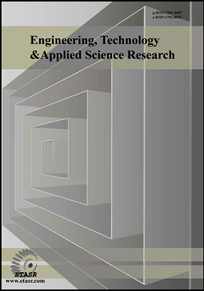Performance Investigation of an Inflatable Solar Dryer with Steel-Can Solar Air Heater for Drying Coffee and Corn
Received: 5 April 2022 | Revised: 14 April 2022 | Accepted: 18 April 2022 | Online: 20 May 2022
Corresponding author: C. L. Oria
Abstract
Coffee and corn are the two most important crops in the Philippines. One of the most critical stages, where crop management can be improved, is drying. In coffee, a moisture level of 12% is optimum for minimizing quality degradation throughout lengthy storage periods, whereas, corn requires a moisture content of 13%. With the demand for simple and cost-effective drying technologies, an Inflatable Solar Dryer (ISD) was created and adapted using a Hohenheim-type solar tunnel and Salvatierra-Rojas’ study. A mesh wire served as a drying space and was placed inside the ISD to avoid moisture condensation. A clear polyethylene (PE) film is attached to a reinforced black Polyvinyl Chloride (PVC) film by a zipper to produce a drying tunnel. The tunnel does not require a foundation because the pressure generated by a solar-powered fan sufficiently stabilizes it. The ISD also incorporated steel cans as solar air heaters to boost the temperature of entering air into the chamber and gradually provide heated air temperature to the bottom parts of the crops. Crops were scattered on the mesh wire and blended with a rake. Drying in the open sun was also done in parallel for comparison purposes. After protracted drying, both crops reached the required moisture content. The trial found that the weight of both crops was affected by the drying duration. The difference in weight for coffee is 1.1kg, while for corn is 0.5kg exhibiting a significant advantage in ISD.
Keywords:
postharvest management, corn, coffee, inflatable solar dryer, solar air heater, solar-powered fanDownloads
References
Statista Research Department, Share of people employed in the agriculture industry in the Philippines between 2019 and 2020. Statista, 2021.
L. C. Domingo, "Philippine coffee industry gets boost," The Manila Times, Manila, Philippines, Mar. 23, 2018.
P. Corpuz, Philippines: Grain and Feed Annual. USDA, 2020.
P. Udomkun et al., "Review of solar dryers for agricultural products in Asia and Africa: An innovation landscape approach," Journal of Environmental Management, vol. 268, Aug. 2020, Art. no. 110730. DOI: https://doi.org/10.1016/j.jenvman.2020.110730
J. B. Hussein, M. A. Hassan, S. A. Kareem, and K. B. Filli, "Design, Construction and Testing of a Hybrid Photovoltaic (PV) Solar Dryer," International Journal of Engineering Research and Science, vol. 3, no. 5, pp. 1–14, May 2017. DOI: https://doi.org/10.25125/engineering-journal-IJOER-MAY-2017-4
A. Salvatierra-Rojas, M. Nagle, M. Gummert, T. de Bruin, and J. Müller, "Development of an inflatable solar dryer for improved postharvest handling of paddy rice in humid climates," International Journal of Agricultural and Biological Engineering, vol. 10, no. 3, pp. 269–282, May 2017.
M. Angelovič, K. Krištof, J. Jobbágy, P. Findura, and M. Križan, "The effect of conditions and storage time on course of moisture and temperature of maize grains," BIO Web of Conferences, vol. 10, 2018, Art. no. 02001. DOI: https://doi.org/10.1051/bioconf/20181002001
E. M. Kyaw, I. W. Budiastra, Sutrisno, and Samsudin, "Estimation of moisture content in Liberica coffee by using near infrared spectroscopy," IOP Conference Series: Earth and Environmental Science, vol. 542, no. 1, Apr. 2020, Art. no. 012013. DOI: https://doi.org/10.1088/1755-1315/542/1/012013
K. Lutz, W. Mühlbauer, J. Müller, and G. Reisinger, "Development of a multi-purpose solar crop dryer for arid zones," Solar & Wind Technology, vol. 4, no. 4, pp. 417–424, Jan. 1987. DOI: https://doi.org/10.1016/0741-983X(87)90016-6
N. B. Khedher, "Experimental Evaluation of a Flat Plate Solar Collector Under Hail City Climate," Engineering, Technology & Applied Science Research, vol. 8, no. 2, pp. 2750–2754, Apr. 2018. DOI: https://doi.org/10.48084/etasr.1957
M. A. Aichouni, N. F. Alshammari, N. B. Khedher, and M. Aichouni, "Experimental Evaluation of Nano-Enhanced Phase Change Materials in a Finned Storage Unit," Engineering, Technology & Applied Science Research, vol. 10, no. 3, pp. 5814–5818, Jun. 2020. DOI: https://doi.org/10.48084/etasr.3616
N. B. Khedher, "Numerical Study of the Thermal Behavior of a Composite Phase Change Material (PCM) Room," Engineering, Technology & Applied Science Research, vol. 8, no. 2, pp. 2663–2667, Apr. 2018. DOI: https://doi.org/10.48084/etasr.1824
Downloads
How to Cite
License
Copyright (c) 2022 C. Oria, E. V. Palconit

This work is licensed under a Creative Commons Attribution 4.0 International License.
Authors who publish with this journal agree to the following terms:
- Authors retain the copyright and grant the journal the right of first publication with the work simultaneously licensed under a Creative Commons Attribution License that allows others to share the work with an acknowledgement of the work's authorship and initial publication in this journal.
- Authors are able to enter into separate, additional contractual arrangements for the non-exclusive distribution of the journal's published version of the work (e.g., post it to an institutional repository or publish it in a book), with an acknowledgement of its initial publication in this journal.
- Authors are permitted and encouraged to post their work online (e.g., in institutional repositories or on their website) after its publication in ETASR with an acknowledgement of its initial publication in this journal.






